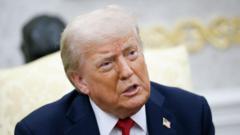In a bold move, US President Donald Trump declared on Monday that the United States will supply "top-of-the-line weapons" to Ukraine, coordinated through NATO allies, while simultaneously issuing a stark warning to Russia regarding economic sanctions. Following discussions with NATO chief Mark Rutte in Washington, Trump expressed his dissatisfaction with Russia, emphasizing that the US aims to empower Ukraine to pursue its objectives more assertively.
Rutte, affirming the US's commitment, indicated that European nations would provide Ukraine with vital military support, including their own Patriot air defense systems, while the US would replenish these systems. Specifics around the type and scope of weaponry were sparse, but Rutte confirmed that the agreement covers essential "missiles and ammunition".
Trump reinforced the urgency of the situation, stating that Russia must negotiate a peace deal within 50 days, or face 100% secondary tariffs targeting any country maintaining trade ties with Moscow. This would mean that nations like India, which continue to buy Russian oil, would see US businesses burdened with hefty tariffs on Indian goods, ultimately discouraging trade with those countries. By this logic, the sanctions aim to cripple Russia's economic capacity, significantly affecting its funding for the ongoing war given that oil and gas constitute a large portion of its revenue.
Interestingly, following Trump's announcement, Russian financial markets reacted positively, with the Moscow Stock Exchange Index surging, which analysts attributed to expectations of Trump announcing even stricter measures. While the specifics of the tariffs and military assistance remain vague, this marked Trump's first commitment to delivering additional military support since his return to office.
Throughout the briefing, Trump's tone towards Putin was notably critical, suggesting that Ukraine's actions must be acknowledged as contributing factors to the conflict escalation. Expressing frustration over the failures of negotiation, he claimed that numerous pleasant phone calls with the Russian president have not translated into reduced hostilities. He remarked, "At a certain point talk doesn't talk, it's got to be action," implying that constant dialogue has yielded little substantial progress.
While two ceasefire negotiations between Russia and Ukraine took place earlier this year, no further talks have been planned. Ukrainian President Zelensky is currently receiving US envoy Keith Kellogg in Kyiv and has publicly appreciated Trump's ongoing assistance.
The Kremlin's initial responses indicated a mix of skepticism and nonchalance, with analysts in Moscow framing Trump's tariff threats as potential political posturing rather than a credible step towards peace. Pro-Kremlin commentator Sergei Markov labeled the tariffs as "a bluff," while Senator Konstantin Kosachev noted that with evolving military and diplomatic dynamics, the next 50 days could lead to significant changes in the conflict’s landscape.
This development illustrates the complexities of international relations and military support amidst ongoing tensions in Ukraine, further emphasizing the vital role of diplomacy and economic strategies in conflict resolution.




















